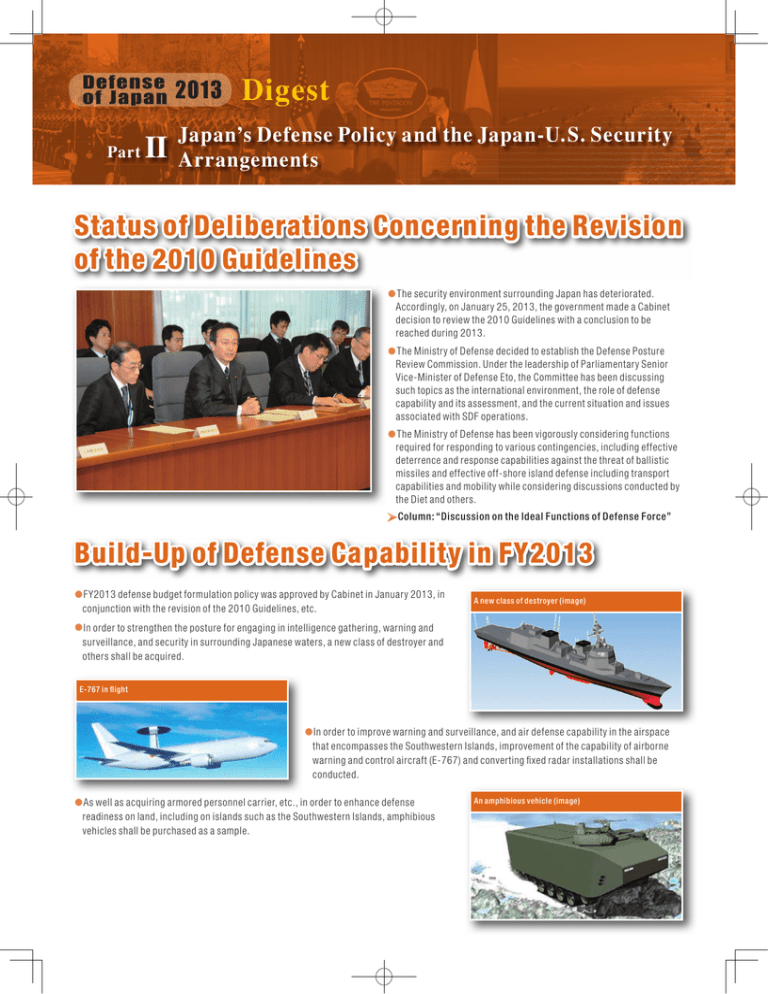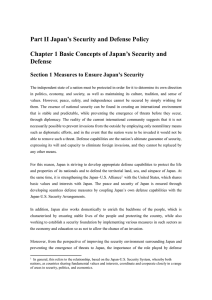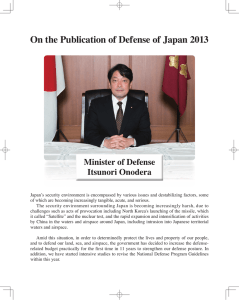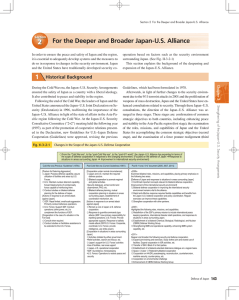Digest II Status of Deliberations Concerning the Revision of the 2010 Guidelines
advertisement

Defense of Japan Part II 2013 Digest Japan’s Defense Policy and the Japan-U.S. Security Arrangements Status of Deliberations Concerning the Revision of the 2010 Guidelines ● The security environment surrounding Japan has deteriorated. Accordingly, on January 25, 2013, the government made a Cabinet decision to review the 2010 Guidelines with a conclusion to be reached during 2013. ● The Ministry of Defense decided to establish the Defense Posture Review Commission. Under the leadership of Parliamentary Senior Vice-Minister of Defense Eto, the Committee has been discussing such topics as the international environment, the role of defense capability and its assessment, and the current situation and issues associated with SDF operations. ● The Ministry of Defense has been vigorously considering functions required for responding to various contingencies, including effective deterrence and response capabilities against the threat of ballistic missiles and effective off-shore island defense including transport capabilities and mobility while considering discussions conducted by the Diet and others. Column: “Discussion on the Ideal Functions of Defense Force” Build-Up of Defense Capability in FY2013 ● FY2013 defense budget formulation policy was approved by Cabinet in January 2013, in conjunction with the revision of the 2010 Guidelines, etc. A new class of destroyer (image) ● In order to strengthen the posture for engaging in intelligence gathering, warning and surveillance, and security in surrounding Japanese waters, a new class of destroyer and others shall be acquired. E-767 in fl ight ● In order to improve warning and surveillance, and air defense capability in the airspace that encompasses the Southwestern Islands, improvement of the capability of airborne warning and control aircraft (E-767) and converting fi xed radar installations shall be conducted. ● As well as acquiring armored personnel carrier, etc., in order to enhance defense readiness on land, including on islands such as the Southwestern Islands, amphibious vehicles shall be purchased as a sample. An amphibious vehicle (image) Chapter 1 DIGEST The Basic Concepts of Japan’s Security and Defense Policy The National Defense Program Guidelines and the Build-Up of Defense Capability Chapter 2 Defense-Related Expenditures (First Increase in 11 Years) (100 million yen) 50,000 49,385 49,198 49,392 49,262 49,215 49,000 48,760 48,297 47,903 48,000 47,815 47,426 47,028 47,000 46,804 46,826 46,625 46,000 1999 2000 2001 2002 2003 2004 2005 2006 2007 2008 2009 2010 2011 46,453 2012 2013 (FY) SACO関係経費と米軍再編経費のうち地元負担軽減分を含まない。 11年度は49, 319億円、 12年 (注) 上記の計数は、 これらを含めた防衛関係の総額は、 355億円、 13年度は49, 550億円、 14年度は49, 557億円、 15年度は49, 527億円、 16年度は49, 026億円、 17年度は48, 560億円、 18年度は48, 度は49, FY2013, defense-related expenditures, which had been declining continuously since FY2003, were increased in real terms for the fi rst time in 136億円、 19年度は48, 013億円、 20年度は47, 796億円、 21年度は47, 741億円、 22年度は47, 903億円、 23年度は47, 752億円、 24年度は47, 138億円、 11 years, in 25年度は47, order to reinforce preparedness aimed at protecting the lives and property of the populace and the nation’s land, sea, and airspace, in 538億円になる。 ● In light of the increasingly harsh security environment. Stable Use of Global Commons (Outer Space, Cyberspace, and the Oceans) ● In recent years, risks to the stable use of global commons, such as outer space, cyberspace, and the oceans, have become a new security issue. The Ministry of Defense will actively cooperate with government-wide initiatives. P-1 next-generation fi xed-wing patrol aircraft Kimiya Yui, an SDF serviceman-turned-astronaut (see column) JAXA/NASA Defense of Japan Part II 2013 Digest Japan’s Defense Policy and the Japan-U.S. Security Arrangements The Japan–U.S. Security Arrangements The Signifi cance of the Japan–U.S. Security Arrangements ● Based on the Japan–U.S. Security Treaty, the Japan-U.S. Security Arrangements constitute one of the pillars of Japan’s national defense. ● The Japan–U.S. Alliance, having the Japan-U.S. Security Arrangements as its core, is indispensable to maintain not only the peace and security of Japan, but also that of the entire Asia-Pacifi c region. ● The military presence of the U.S. forces in Japan not only contributes to the defense of Japan, but also functions as deterrence against and response to contingencies in the Asia-Pacifi c region, and serves as a core element of the Japan-U.S. Security Arrangements. Japan-U.S. Bilateral Training and Exercises ● The SDF and the U.S. forces have been constantly conducting various bilateral training and exercises. ● Such training and exercises not only contribute signifi cantly to maintaining and enhancing the Japan-U.S. bilateral response capabilities by deepening mutual understanding of capabilities and tactics, but also are effective for improving tactical skills on each side. ● Holding bilateral exercises at effective times, places, and scales demonstrates the unifi ed commitment and capabilities of Japan and the United States, which has a deterrent effect. DIGEST Chapter 3 Strengthening of the Japan–U.S. Security Arrangements MV-22 Osprey Deployment in Okinawa ● The MV-22 of the U.S. Marine Corps is a highly capable aircraft; compared with the CH-46, it can fl y twice as fast, can carry three times the payload, and has four times the operational range. ● Its deployment to Okinawa will strengthen the deterrence of the USFJ as a whole and greatly contribute to the peace and stability of the region. ● Considering that the safety of MV-22 operations in Japan is fully confi rmed, the Government of Japan released “On MV-22 Osprey Deployment to Okinawa” in September 2012, and then fl ight operation of the MV-22 Osprey was started in Japan. Efforts to Strengthen Japan-U.S. Defense Cooperation Column “Japan-U.S. Summit Meeting” (February 2013) ● Prime [Cabinet Public Relations Offi ce] Minister Abe explained that Japan was working to strengthen its own defense capabilities and that Japan had started to study the right of collective self-defense. The Prime Minister emphasized that Japan would ensure that these efforts will contribute to the strengthening of the Alliance. In addition, Prime Minister Abe expressed his intention to promote cooperation in wide-ranging areas in order to enhance the deterrence of the Japan-U.S. Security Alliance. Furthermore, he added that Japan would like to start reviewing the Guidelines for Japan-U.S. Defense Cooperation. ● President Obama stated that the Japan-U.S. Alliance was of great importance also for the U.S., a Pacifi c nation, and welcomed Japan’s efforts to strengthen the Alliance. Meeting of Defense Minister and U.S. Secretary of Defense ● In April 2013, Minister of Defense Onodera had a meeting with Secretary of Defense Hagel, agreeing on the signifi cance of stepping up the Japan-U.S. cooperative relationship to a new stage. ● Minister Onodera explained close bilateral coordination between Japan and the U.S., as well as close trilateral coordination among Japan, the U.S., and South Korea in dealing with North Korea, and explained that Japan was determined to protect the land, waters, and airspace of the Senkaku Islands. ● Secretary Hagel stated that Article 5 of the Japan-U.S. Security Treaty applied to the Senkaku Islands and that he was opposed to any unilateral action that aimed to change the status quo by force. ● They welcomed the progress in the bilateral discussions to share views on the strategic environments, which serve as a basis for the reviewing process of the Guidelines, and agreed to continue intensive discussions. Measures Relating to the Stationing of U.S. Forces in Japan, including their Realignment ● As for the Futenma Replacement Facility, the Ministry of Defense completed the procedure of environmental impact assessment in January 2013, and submitted the application for approval of the reclamation of the pubic water body to the Governor of Okinawa in March 2013. ● As for the return of land areas south of Kadena Air Base, Japan and the U.S. agreed to stipulate the return schedule including the specifi c years, and announced the consolidation plan on April 5, 2013. [Cabinet Public Relations Offi ce]


